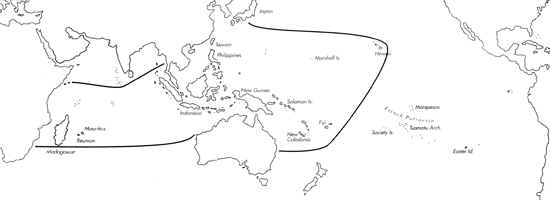
Skip Navigation Links
View access keys for this site.

Range: Natal and E. Africa to Hawaii, Samoa and Tonga, Japan to Australia; absent from Red Sea.
Description: Moderately large to large, solid. Last whorl conical or ventricosely conical to broadly or broadly and ventricosely conical; outline convex near shoulder, less so or straight below; left side concave near base. Shoulder angulate, sometimes subangulate. Spire low, outline slightly sigmoid, straight or concave. Larval shell of 3-3.5 whorls, maximum diameter about 0.9 mm. First 0.5 postnuclear whorls tuberculate, smooth within following 0.5 whorl. Teleoconch sutural ramps almost flat to slightly convex, with 2 increasing to 5-7 spiral grooves. Last whorl with widely spaced, often weak spiral ribs at base; in subadults, ribs followed by variably spaced spiral rows of punctations sometimes retained basally in small adults.
| Shell Morphometry | ||
|---|---|---|
| L | 55-98 mm | |
| RW | 0.33-0.80 g/mm | |
| ((L 55-85)) | ||
| RD | 0.65-0.75 | |
| PMD | 0.82-0.92 | |
| RSH | 0.05-0.12 | |
Ground colour white. Last whorl with broad, brown or olive spiral bands, leaving white bands at shoulder and centre. Central band edged with dark brown markings, some of which cross the band; subshoulder band crossed by dark brown streaks. Spiral colour bands interspersed by spiral rows of dark brown coarse dots or axial streaks of varying length. Numerous spiral rows of minute brown dots extend from base to shoulder, often sparse within white bands and densely clustered anteriorly, producing a dark brown base; dots become axially rather than spirally aligned during growth. Larval whorls yellow; adjacent sutural ramps greenish yellow. Later sutural ramps white, with variably broad, brown to black radial blotches, some of which extend as streaks to subshoulder area. Aperture white. Pattern consistent from juveniles of about 15 mm to the adult stage.
Periostracum yellowish to brownish olive, rather thin but less so towards outer lip, translucent to almost opaque, with widely spaced and strongly tufted spiral ridges on last whorl and close- set spiral rows of bristles on sutural ramps.
Foot varies from greyish yellow to olive or greenish black, has yellow to dark yellowish green sides, is sometimes dotted with white and mottled with black and may grade to nearly solid black on anterior part of dorsum. Rostrum yellowish green to black. Tentacles yellowish green, sparsely mottled with dark grey to black posterior from the tip. Siphon yellowish green, heavily mottled with black dorso-laterally and sparsely ventrally; sometimes either completely black or black except for yellowish green anterior portion (Pl. 75, Fig. 42; Pl. 80, Third row, left) (Walls,[1979]; Chaberman, pers. comm., 1981; Pearson, unpubl. observ.).
Radular teeth similar to those of C. vexillum but with weaker serration (Peile, 1939).
Habitat and Habits: Intertidal and entire subtidal; in Philippines to about 240 m; most common on slightly subtidal reef flats and stretches of sand passing into reef flats, occurring on sand under coral rocks, on coral rock with coralline algal encrustation or in holes and crevices. It feeds on eunicid and nereid polychaetes. (Kohn, 1959a, 1968; Kohn & Weaver, 1962; Kohn & Nybakken, 1975; Reichelt & Kohn, 1985; Cernohorsky, 1964, 1978; Richards, pers. comm., 1989). Egg capsules deposited on the underside of rocks, arranged in groups of about 12 and each group consisting of 2 parallel rows. Egg diameter of about 160 ┬Ám predicts a minimum pelagic period of 27 days (Risbec, 1932; Perron & Kohn, 1985).
Discussion: C. capitaneus is similar to C. vexillum, C. mustelinus, C. namocanus, C.trigonus and C. capitanellus. C. vexillum attains larger size, has more spiral grooves (ca. 10) on the late sutural ramps, and lacks the spiral rows of rather small dark brown markings in the adult last whorl pattern. In both suspecies of C. vexillum, greenish and olive tones are absent from last whorl pattern, and C. v. vexillum tends to have a narrower last whorl than C. capitaneus (RD 0.58-0.72). C. mustelinus often has a narrower last whorl (RD 0.56-0.70), weakly concave late sutural ramps and a less spirally maculated last whorl pattern. Dark brown markings across the central white band and axial rows of minute brown dots are usually absent in C. mustelinus, spiral rows of coarse brown dots occur only at subshoulder area and centrally, and the spiral colour bands consistently lack dark brown axial streaks. For the distinctions from C. namocanus, C. trigonus, and C. capitanellus see the DISCUSSIONS of those species. C. ceciliae (Pl. 23, Fig. 14) is based on a subadult specimen of C. capitaneus with spiral rows of deep punctations on the last whorl.

C. capitaneus range map
This section contains verbatim reproductions of the accounts of 316 species of Conus from the Indo-Pacific region, from Manual of the Living Conidae, by R÷ckel, Korn and Kohn (1995). They are reproduced with the kind permission of the present publisher, Conchbooks.
All plates and figures referred to in the text are also in R÷ckel, Korn & Kohn, 1995. Manual of the Living Conidae Vol. 1: Indo-Pacific Region.
The range maps have been modified so that each species account has it own map, rather than one map that showed the ranges of several species in the original work. This was necessary because each species account is on a separate page on the website and not confined to the order of accounts in the book.
Return to framed version (returns to search page)